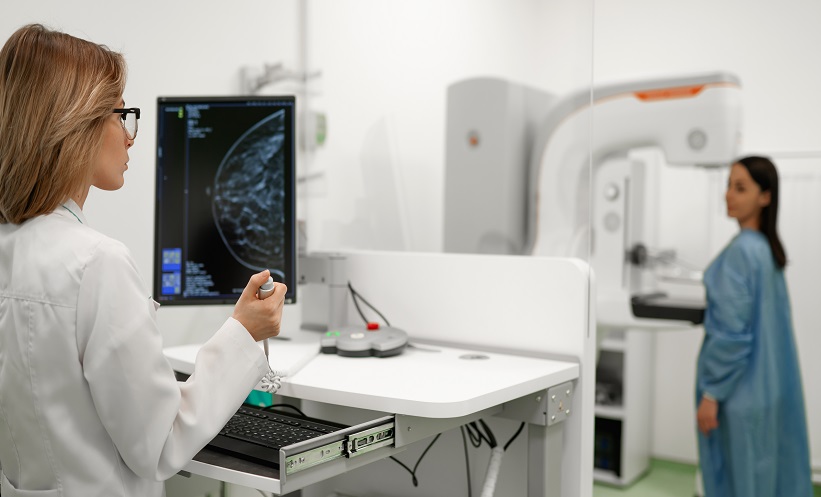BACKGROUND AND AIMS
Radiomics, an emerging paradigm in medical imaging, entails the quantitative analysis of tumour features, and has exhibited potential in predicting treatment responses and outcomes. Furthermore, within the domain of -omics assessments, the significance of comprehensive genetic evaluation in non-small cell lung cancer (NSCLC) is on the rise, influenced by both biological and therapeutic considerations.
The aim of this study was to correlate radiomics features with the genetic results obtained from liquid biopsy in patients with lung tumours. The prediction of tumour genetics in radiomics relies on the presumption of conducting a non-invasive evaluation of molecular characteristics in tumour tissues, which can be challenging in certain tumour types, such as NSCLC. Therefore, in this context, the authors considered it pertinent to explore and generate hypotheses regarding the technical feasibility of identifying associations between genomics acquired through liquid biopsy assessments and radiomics.
MATERIALS AND METHODS
This observational, prospective study integrated radiomic perspectives using CT and genomic perspectives, through next-generation sequencing applied to liquid biopsies. The authors included 62 patients with NSCLC who underwent pre-surgery CT (Revolution™ 128 MDCT, GE HealthCare, Chicago, Illinois, USA) at the Radiology Department of Campania University Luigi Vanvitelli, Naples, Italy. Every patient for whom liquid biopsy was performed gave informed consent for the genetic analysis. For the radiomic analysis, image processing CT volumes were manually delineated using ITK-SNAP 3.8.0 (University of Pennsylvania, Philadelphia, USA). Radiomics features (first order: Gray Level Co-occurrence Matrix, Gray Level Run Length Matrix, Gray Level Size Zone, Gray Level Dependence Matrix, and Neighbouring Gray Tone Difference Matrix) were computed using Pyradiomics1 in Python 3.7 (Python Software Foundation, USA) environment.
Radiomic features were derived from CT images, and genetic assessments were performed using a comprehensive panel targeting 523 cancer-related genes. For the statistical analysis, association between radiomic features and gene mutations were assessed using feature importance based on receiver operating characteristic curve analysis; moreover, a machine learning approach based on support vector machine was used to evaluate the ability of radiomic features to predict gene mutations.
Associations between radiomic features and genetic mutations were established using the area under the receiver operating characteristic curve. Machine learning techniques, including support vector machine classification, aimed to predict genetic mutations based on radiomic features. The prognostic impact of selected gene variants was assessed using Kaplan–Meier curves and log-rank tests.
RESULTS
Sixty-two patients underwent screening, with 53 being comprehensively characterised radiomically and genomically. This group was predominantly male (68.4%), and adenocarcinoma was the prevalent histological type (73.7%). Most patients exhibited ECOG Performance Status of 0 or 1 (87.7%), and 91.2% had a history of former or current smoking. Disease staging was distributed across I–II (38.6%), III (31.6%), and IV (29.8%). Significant correlations were identified with mutations of ROS1 p.Thr145Pro (shape_Sphericity), ROS1 p.Arg167Gln (glszm_ZoneEntropy, firstorder_TotalEnergy), ROS1 p.Asp2213Asn (glszm_GrayLevelVariance, firstorder_RootMeanSquared), and ALK p.Asp1529Glu (glcm_Imc1). Patients with the ROS1 p.Thr145Pro variant demonstrated markedly shorter median survival compared to the wild-type group (9.7 months versus not reached; p=0.0143; hazard ratio: 5.35; 95% confidence interval: 1.39–20.48).
CONCLUSION
This study contributes to advancing the prediction of cancer genetics through the application of non-invasive radiomic techniques. The prediction of tumour genetics in radiomics hinges on the assumption of conducting a non-invasive assessment of molecular characteristics in tumour tissues, which can pose challenges in certain tumour types, such as NSCLC. Therefore, within this context, the authors deemed it relevant to explore and formulate hypotheses regarding the technical feasibility of identifying associations between genomics obtained through liquid biopsy assessments and radiomics.
Specific radiomic features illustrate the capability to predict non-synonymous mutations of ROS1 and ALK in patients with NSCLC. Investigating the prediction of cancer genetics using non-invasive radiomic techniques represents an innovative frontier in scientific research, which is currently undergoing extensive investigation. Research on the use of conventional CT features and CT image-based radiomic features to predict the gene mutation status of lung cancer is still in its nascent stages.
The integration of radiomic techniques in predicting cancer genetics holds potential, but is constrained by cost and technological limitations. Despite these challenges, the authors’ study explores the relationships between genomics and radiomics, revealing specific genetic variants associated with radiomic features. While acknowledging limitations, particularly the small sample size and the lack of actionable mutations, this research lays the groundwork for broader investigations aiming to link radiomics and genomics in NSCLC. The ultimate objective is to improve prognostic accuracy and refine therapeutic strategies.







